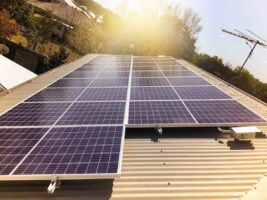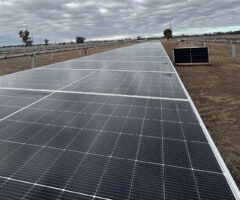The tough grid constraints which has cut the output of five solar farms in Victoria and NSW by half over the last six months could be relaxed by the end of April, and hopefully ease the path for a growing queue of other large scale wind and solar projects to finalise their grid connections and commissioning.
Five solar farms – Broken Hill in NSW, and the Wemen, Karadoc, Bannerton and Gannawarra solar farms in Victoria (nearly four fifths of that state’s solar capacity) – have had their output reduced by half since early September because of fears of “uncontrolled oscillations” from their inverters if a major transmission outage reduced system strength in the area.
The issue has been a hotbed of debate and controversy – both within AEMO and in the wider renewables sector – and led to a series of “emergency” meetings earlier this year because its impacts cascaded well beyond the five solar farms, which have lost tens of millions of dollars in revenue from the cutbacks.
It also caused AEMO to warn more than a dozen other large scale wind and solar projects that their connections would likely face significant delays, possibly up to a year, after being told that they could only connect in sequence, or “one at a time”.
Some short and medium term solutions are being sought – including the up-rating inverter controls and possibly installing synchronous condensers, but other projects are being told not to bother even with construction until longer term solutions such as new transmission links are built later this decade.
See: Wind, solar projects warned of seven year delays in Victoria, NSW.
RenewEconomy understands that the inverter supplier common to all the solar farms, SMA, has found a long term solution by “fine-tuning” the control systems so that they follow any voltage changes like “super-glue”. New “firm-ware” is now being downloaded at some of the solar farms, and testing should take place in the next week or two. If all goes to plan, the constraints could be lifted either partially or in their entirety by the end of the month.
Alex Wonhas, AEMO chief system design and engineering officer, told RenewEconomy that the solar farms are implementing and preparing to test the new ‘tuning solution’ in mid-April with AEMO and the network owners (NSPs).
If these tests are successful, the current constraints will be revised, although AEMO would not speculate whether this meant the constraints would be eliminated entirely, or just relaxed.
“Our collaborative and transparent efforts are progressing towards managing the unprecedented technical issues impacting grid performance and operational stability in the West Murray Zone,” Wonhas said in an emailed statement.
This week, AEMO held a workshop with project developers, equipment manufacturers and the Clean Energy Council on possible changes to the connection modelling process, in an effort to find better collaboration and unlock the blockages facing new projects. There will be a particularly focus on detailed modelling known as PSCAD.
There will also be a ‘sequencing workshop’ to try to seek solutions for uncommitted projects, and a West Murray webinar to explain more about the system strength challenges in the West Murray zone.
“All commissioning and committed projects have has their assessment status confirmed based on our proposed sequencing approach to facilitate an expeditious connection process in the region while maintaining system security,” Wonhas said.
“Feedback and engagement from generators, network businesses and industry groups has been encouraging and productive.”
RenewEconomy also understands that there have been changes to the personnel and structure of the connections team in Victoria, where AEMO – quite uniquely – has responsibility for grid connections. In other states, the main transmission provider oversees the connections process.
It is also suggested by some observers that the issue – and the impact on the solar inverters if a major transmission link was lost in what is already a weak area of the grid – was actually identified a while ago, as far back as late 2018.
But the observers say that – like so many things in Australia’s electricity grid – the simplest and most obvious solutions were not possible because of the often archaic rules that govern the industry, and the endless red tape.
It adds to a growing list of complaints and frustrations, including complex new connection requirements, the difficulties of adding or including battery storage, the lack of key infrastructure investment, proposed new rules surrounding transmission funding, and the uncertainty around policy and a completely new rule-book that could be put into place by 2025.
On the other hand, AEMO has identified a road map that will take Australia to at least 70 per cent renewables by 2040, or up to 90 per cent in a “step change scenario”, and identified the infrastructure and rule changes required. Many in the energy sector, however, are convinced that given falling technology costs the clean energy transition can, and must, happen more quickly than that.
RenewEconomy and its sister sites One Step Off The Grid and The Driven will continue to publish throughout the Covid-19 crisis, posting good news about technology and project development, and holding government, regulators and business to account. But as the conference market evaporates, and some advertisers pull in their budgets, readers can help by making a voluntary donation here to help ensure we can continue to offer the service free of charge and to as wide an audience as possible. Thankyou for your support.








